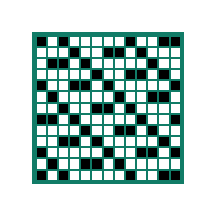What is Musaic ?
- Musaic is a concret representation of an abstract object.
- An object without borders limits (physical, cultural), revealing relationships between intervallic structures.
A musaic is a multi-faceted visual object (4 faces), one face being, at most, made up of 2 distinct patterns (color harmonic structure, known as intervallic structure).
The canonical representation of a musaic is based on a matrix canvas. The dual nature of a musaic is probably its major characteristic:
- Theoretical: Symbolic (abstract - based on PCS) representation of intervallic structures
- Practical: System (concrete - based on Pitch) in which can be organized all the diagrams (chords & sacles) played by the fingers on certain instruments.
Example of Musaic ?




click on image to trigger operation...
Which scope ?
The 88 musaics are at the intersection of several disciplines : music, harmony, mathematics, didactics, instrumental play (in particular for the guitar tuned in fourths « P4 tuning » but not only)
Prerequisites ?
Basic knowledge of harmony is recommended, but not necessary..
Why this title (88-Musaics)?
The musaics are both abstract and real geometric objects.
The study has many “ingredients” other that musaics : polygons in a musical dial, diagrams, graphs … and even projections of hypercubes.
And if these forms are here at the service of musical harmony (atonal and tonal), they will also be observed according to several other points of view: geometry, set theory, group theory, didactics…
As there are exactly 88 musaics, and not a more, in this study, musaics and 88-musaics are synonymous. Besides this study, the term 88-musaics is preferable because “musaic” is not a registered designation and can already be used by others to identify different concepts.
What is the origin of the word “musaic”?
It is a neologism, condensed from “mosaic”, “music” and “muse”. It testifies to the strong interest we have in the natural relationships between form (visual, palpable …) and musical structures (is, chord, scale, …), with the hope that musaicis could be an inspiration to revisit old musical repertoires and discover other ways.
We warn the reader that the other essential components of music (rhythm, timbre, expression …) are not covered by the musaic and this study in general.
Historically, the term “harmonic mosaic” had been used.
Why « 88 » ?
It is a pictogram reduction of the whole possible combinations of the twelve pitch classes forming the temperated system (equal division of the octave), that is, 2 ^ 12 = 4096 <=> 88.
What is their interest ?
In addition to their dual nature - which alone opens up a vast area for cognitive research - the musaic representation:
- Allows - by virtually immediate recognition of patterns - identification of intervallic structures
- Facilitates the understanding of certain harmonic properties, allowing an original didactic
- Is a tool at the service of the Musical Set Theory : see Set Theory Complete and Music Set Theory
- Is an illustration of the Group Theory
And art in all this ?
The trellis (metallic structure) is not the fruit (living nature that grows on it). Needless to say, the very perfect theoretical knowledge of an art, whatever it may be, does not replace its practice, which is often a way of going beyond this knowledge: especially in art, rules and structures are made for Be exceeded

(Garden : Chaumont-sur-Loire 47.478, 1.181)